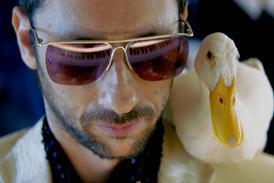The world’s first oil-painted animation explores the mysterious death of Vincent Van Gogh

Dir: Hugh Welchman, Dorota Kobiela. UK, Poland. 2017. 93 mins
Hand painted in oils by around 100 artists, this distinctive animation draws inspiration from the feverish paintings of Vincent Van Gogh to explore the nature of his death. The story is set one year after the troubled painter passes away, from a gunshot wound to his stomach. Armand Roulin (Douglas Booth), an occasional model for the artist and the son of postman Joseph (Chris O’Dowd) has been charged by his father to take an undelivered letter from Van Gogh to his brother Theo. Initially unenthusiastic, Roulin plunges into a personal odyssey through which he tries to unpick the details surrounding the death of the “father of modern art”.
The point of the film is its visual impact
The novelty of the film’s look and the process of its animation – it is the first oil-painted animated feature – should be a selling point which could help the picture make the jump from festival curio to art house object of interest. The fact that the style walks a precarious line between homage to Van Gogh’s paintings and corny knock off may be a turnoff for audiences that take the artist’s legacy seriously.
Although the main story plays out twelve months after the death of Van Gogh, there are plenty of flashbacks to provide exposition. These are distinguished by a leaching out of the colour, although the facts of the past are by no means as black and white as the animation as Armand finds himself buffeted by conflicting accounts in his search for the truth. In a narrative which is perhaps a little contrived, Armand retraces the story of the artist’s final few weeks by meeting many of the people who, coincidentally, featured in the paintings that resulted from Van Gogh’s frenzy of creativity.
His first port of call, Vincent’s beloved brother and longterm supporter Theo hits a brick wall, as Theo died six months previously. A conversation with Pere Tanguy (John Sessions), the supplier of paint (and purveyor of gossip) for a whole generation of Parisian artists, leads Armand to Doctor Gachet. But Gachet is busy, and his territorial housekeeper Louise Chevalier (Helen McCrory) sends Armand away, making no secret of her low opinion of Van Gogh.
Armand checks into Van Gogh’s favoured tavern and, through Adeline (Eleanor Tomlinson) the chatty daughter of the proprietors, learns that Van Gogh was close to Gachet’s daughter Marguerite (Saoirse Ronan) and that the artist and the doctor had had a furious row a few days before his death. Mystery over the ownership of the gun which fired the bullet which killed Van Gogh further clouds the truth – did it belong to Adeline’s father? Or to the rambunctious teenager Rene Secretan, who was known to bully Van Gogh? And what of the testimony of the other doctor who claimed that the trajectory of the bullet meant that the wound couldn’t possibly have been self-inflicted
Armand’s investigation is, however, ultimately of secondary interest. The point of the film is its visual impact. Of a varied colour palette, golds, ochres, rusts and a vivid cornflower blue leap out. And the animation taps into the dynamism of Van Gogh’s painting style, with individual brush strokes flickering like light on water. It’s rare that the film contributes anything more than an approximation of Van Gogh’s work. However, there is a stunning scene showing Van Gogh’s tortured reflection in the surface of a washing basin which feels like a work of art on its own terms.
Production company: Trademark Films, BreakThru Productions
International Sales: Cinema Management Group info@cinemamanagementgroup.com
Producers: Sean M. Bobbitt, Ivan Mactaggart, Hugh Welchman
Screenplay: Jacek von Dehnel, Dorota Kobiela, Hugh Welchman
Cinematographer: Tristan Oliver, Lukasz Zal
Editor: Dorota Kobiela, Justyna Wierszynska
Production design: Matthew Button
Music: Clint Mansell
Starring: Douglas Booth, Robert Gulaczyk, Saoirse Ronan, Aidan Turner, Helen McCrory, Eleanor Tomlinson, Jerome Flynn, Chris O’Dowd






![The Brightest SunScreen[Courtesy HKIFF]](https://d1nslcd7m2225b.cloudfront.net/Pictures/274x183/3/5/0/1448350_thebrightestsunscreencourtesyhkiff_312678.jpg)















![The Brightest SunScreen[Courtesy HKIFF]](https://d1nslcd7m2225b.cloudfront.net/Pictures/100x67/3/5/0/1448350_thebrightestsunscreencourtesyhkiff_312678.jpg)

